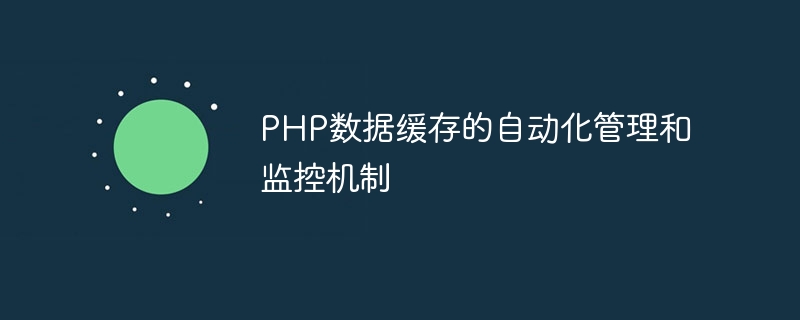Home >Backend Development >PHP Tutorial >Automated management and monitoring mechanism for PHP data cache
Automated management and monitoring mechanism for PHP data cache
- WBOYWBOYWBOYWBOYWBOYWBOYWBOYWBOYWBOYWBOYWBOYWBOYWBOriginal
- 2023-08-10 21:18:291396browse

Automated management and monitoring mechanism of PHP data cache
Introduction:
In modern web applications, data caching is an important technology to improve performance and response time . As a popular server-side programming language, PHP also provides a rich caching mechanism to optimize database queries and calculation-intensive operations. This article will introduce the automated management and monitoring mechanism of PHP data cache and provide some code examples.
1. Basic concepts and principles of data caching
Data caching is to store calculation results or database query results so that they can be reused in subsequent requests, thereby reducing access to the original data source. Among them, the main principle is to store data in memory to increase reading speed.
2. Common ways and methods of PHP data caching
- File caching
File caching is the simplest data caching method, which stores data in the file system . PHP provides a series of file reading and writing functions, and we can use these functions to implement a simple file caching mechanism. Here is a sample code:
function getDataFromCache($key)
{
$cacheFile = "cache/".$key.".txt";
if (file_exists($cacheFile) && (time() - filemtime($cacheFile) < 3600)) {
return file_get_contents($cacheFile);
}
return false;
}
function saveDataToCache($key, $data)
{
$cacheFile = "cache/".$key.".txt";
file_put_contents($cacheFile, $data);
}- Memcached cache
Memcached is a high-performance distributed memory object caching system that stores data in memory. PHP provides Memcached extension to communicate with Memcached server. The following is a sample code:
$memcached = new Memcached();
$memcached->addServer("127.0.0.1", 11211);
function getDataFromCache($key)
{
global $memcached;
return $memcached->get($key);
}
function saveDataToCache($key, $data)
{
global $memcached;
$memcached->set($key, $data, 3600);
}- Redis Cache
Redis is a high-performance key-value storage system that supports multiple data types. PHP provides Redis extension to communicate with Redis server. The following is a sample code:
$redis = new Redis();
$redis->connect("127.0.0.1", 6379);
function getDataFromCache($key)
{
global $redis;
return $redis->get($key);
}
function saveDataToCache($key, $data)
{
global $redis;
$redis->set($key, $data, 3600);
}3. Automatic management of data cache
- Generation of cache Key
In order to ensure the uniqueness and consistency of cached data, A unique cache key needs to be generated. You can use the hash value of related parameters or concatenate the parameters into a string as the key. - Automatically update cache
In order to ensure the timeliness of cached data, the cache can be automatically updated when the data source changes. For example, when the data in the database changes, the new data can be automatically written to the cache after the data update is completed. - Cache expiration mechanism
In order to avoid cache data expiration, you need to set an appropriate cache expiration time. You can use scheduled tasks or periodic checking mechanisms to refresh expired cached data.
4. Monitoring mechanism of data cache
- Monitoring of cache hit rate
Cache hit rate can reflect the effectiveness and performance of cached data. Cache hit ratio can be calculated by monitoring the number of hits and misses for cache queries. - Cache space monitoring
Cache space monitoring can help us understand cache usage and remaining space. You can determine whether the cache space needs to be expanded by monitoring the memory usage of the cache server. - Cache performance monitoring
You can monitor the performance indicators of cache operations, such as read time, write time and hit rate. By monitoring these indicators, potential performance problems can be discovered in time and optimized.
5. Summary
Data caching is an important technology to improve the performance of web applications. PHP provides a variety of caching methods and methods, and we can choose the appropriate caching method according to actual needs. At the same time, automated management and monitoring mechanisms can help us better manage and optimize data caching. The code examples also provide basic methods and techniques for implementing data caching for readers' reference and practice.
The above is the detailed content of Automated management and monitoring mechanism for PHP data cache. For more information, please follow other related articles on the PHP Chinese website!

